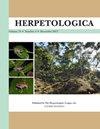伊比利亚西北部沿海拔梯度的两栖类筑巢模式:对保护的启示
IF 1.1
3区 生物学
Q2 ZOOLOGY
引用次数: 0
摘要
摘要:为了了解位于欧洲西伯利亚和地中海地区(加利西亚)之间的一个大型南欧地区的两栖动物元群落的宏观生态结构,我们分析了海拔梯度(0-2036 m)上3627个水点(包括池塘和溪流)中14个物种的存在-不存在矩阵的嵌套性,在11年期间(2003年至2013年)。为了量化嵌套性,我们使用了度量NODF(嵌套重叠递减填充)。我们还探索了嵌套性的年际变化以及阿尔法、贝塔和伽马多样性的时间模式。池塘的最大填充基质在中高海拔处表现出嵌套模式,而对于溪流,嵌套模式出现在低海拔处。在这两种类型的湿地中,嵌套程度都是中等的,约为15-30%。另一方面,在研究期间,无论是池塘和溪流,还是在三个海拔水平上,嵌套度都没有增加或减少。α、β和γ多样性也发现了这种暂时稳定性。检测到的中度嵌套模式很可能是由物种的选择性移除、水源点之间的不良联系、湿地的历史破坏或与放弃传统农业活动相关的重大土地利用变化所解释的。我们的研究结果表明,所研究的两栖动物物种对人类干扰有一定的抵抗力。然而,这些结果强调了从整体上保护元群落的必要性(因为不同地点之间物种更替的相对重要性),并强调了至少在保护区内保护旧马赛克景观的适宜性。我们的结果介于温带和低纬度地区的预期结果之间,可能是因为研究区域是一个生物地理过渡区。本文章由计算机程序翻译,如有差异,请以英文原文为准。
Nestedness Patterns of Amphibian Assemblages in Northwestern Iberia along an Altitudinal Gradient: Implications for Conservation
Abstract: In order to understand the macroecological architecture of an amphibian metacommunity of a large southern European region located between the Eurosiberian and Mediterranean domains (Galicia), we analyzed nestedness from matrices of presence–absence of 14 species in 3,627 water points, including both ponds and streams, along an altitudinal gradient (0–2,036 m), during a 11-yr period (2003–2013). To quantify nestedness, we used the metric NODF (nested overlap decreasing fill). We also explored interannual variability in nestedness and in temporal patterns of alpha, beta, and gamma diversity. The maximally packed matrix for ponds showed a nested pattern at middle and high elevation, whereas for streams, the nested pattern occurred at low elevation. In both types of wetlands, the magnitude of nestedness was moderate, around 15–30%. On the other hand, nestedness was not found to increase or decrease over the study period, for both ponds and streams, or at the three levels of elevation. This temporary stability was also found for alpha, beta, and gamma diversities. The moderate nestedness pattern detected was most likely explained by selective removal of species, a poor connection among water points, historical destruction of wetlands, or major land-use changes associated with the abandonment of traditional farming activities. Our results denote a certain resilience to human disturbance by the studied amphibian species. However, these results stress the need of protecting the metacommunity as a whole (because of the relative importance of species turnover among sites), and emphasize the suitability of preserving the old mosaic landscape at least within protected areas. Our results are intermediate between those expected for the temperate zone and those expected for lower latitudes, likely because the study region is a biogeographical transition area.
求助全文
通过发布文献求助,成功后即可免费获取论文全文。
去求助
来源期刊

Herpetologica
生物-动物学
CiteScore
4.60
自引率
0.00%
发文量
27
审稿时长
>12 weeks
期刊介绍:
Established in 1936, Herpetologica is a quarterly peer-reviewed journal serving herpetologists, biologists, ecologists, conservationists, researchers and the scientific community. The journal contains original research papers and essays about the biology of reptiles and amphibians, and covers many relevant topics including: behavior, conservation, ecology, genetics, morphology, physiology and taxonomy.
 求助内容:
求助内容: 应助结果提醒方式:
应助结果提醒方式:


